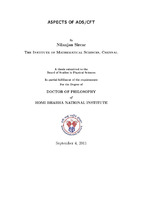- DSpace Home
- →
- IMSc Theses/ Dissertations
- →
- IMSc Theses/ Dissertations
- →
- View Item
JavaScript is disabled for your browser. Some features of this site may not work without it.
| dc.contributor.author | Nilanjan Sircar | |
| dc.date.accessioned | 2011-10-27T07:17:09Z | |
| dc.date.available | 2011-10-27T07:17:09Z | |
| dc.date.issued | 2011 | |
| dc.date.submitted | 2011 | |
| dc.identifier.uri | https://dspace.imsc.res.in/xmlui/handle/123456789/266 | |
| dc.description.abstract | This thesis is devoted to study of two aspects or use of AdS/CFT conjecture: One is the use of AdS/CFT in understanding the IR-cut-off appearing in the resolution of Hagedorn limiting temperature in String Theory via BFSS matrix model. And other is the use of AdS/CFT in understanding of low energy condensed matter system. A brief abstract of these studies are written separately below. Hagedorn Phase Transition and Matrix Model for String Theory: Hagedorn Temperature is the temperature at which the partition function diverges due to the exponential growth in the density of states, which overtakes the Boltzmann suppression factor. BFSS matrix model which describes M-theory in some limit, has membrane degrees of freedom. String like con gurations can be constructed from basic degrees of freedom of the matrix model. Hagedorn temperature can be reinterpreted in terms of new degrees of freedom as a phase transition. In the first part of this thesis, we will construct two phases of matrix model ("string" phase and "clustered phase"), and compare their free energies to fi nd signature of phase transition. It will be shown that, there exist phase transitions between these two con gurations -but only in presence of an IR cut-off. The low temperature phase corresponds to a string (wrapped membrane) phase and so we call this the Hagedorn phase transition. While the presence of an IR cut-off seemingly is only required for perturbative analysis to be valid, the physical necessity of such a cut-off can be seen in the dual super-gravity side using AdS/CFT conjecture. Interestingly the perturbative analysis also shows a second phase transition back to a string phase. This is reminiscent of the Gregory-La amme instability. Duality between Charged BTZ black hole and Luttinger liquids: In the second part of thesis, we study properties of strongly coupled CFT's with non-zero background electric charge in 1+1 dimensions by studying the dual gravity theory - which is a charged BTZ black hole. We will calculate correlators of operators dual to scalars, gauge elds and fermions are studied at both T = 0 and T (not)= 0. In the T = 0 case we will also able to compare with analytical results based on AdS2 and find reasonable agreement. In particular the correlation between log periodicity and the presence of nite spectral density of gapless modes will be seen. The real part of the conductivity (given by the current-current correlator) also vanishes as w → 0 as expected. The fermion Green's function shows quasiparticle peaks with approximately linear dispersion but the detailed structure is neither Fermi liquid nor Luttinger liquid and bears some similarity to a "Fermi-Luttinger" liquid. This is expected since there is a background charge and the theory is not Lorentz or scale invariant. A boundary action that produces the observed non-Luttinger-liquid like behavior (k-independent non-analyticity at w = 0) in the Green's function is discussed. | en_US |
| dc.publisher.publisher | The Institute of Mathematical Sciences | |
| dc.subject | Ads/CFT Conjecture | en_US |
| dc.subject | Matrix Models | en_US |
| dc.subject | Hagedorn Phase Transition | en_US |
| dc.subject | BTZ Black Hole | en_US |
| dc.subject | HBNI Th37 | en_US |
| dc.title | Aspects of ADS/CFT [HBNI Th37] | en_US |
| dc.type.degree | Ph.D | en_US |
| dc.type.institution | HBNI | en_US |
| dc.description.advisor | Sathiapalan Balachandran | |
| dc.description.pages | 166p. | en_US |
| dc.type.mainsub | Physics | en_US |
| dc.type.hbnibos | Physical Sciences |
Files in this item
This item appears in the following Collection(s)
-
IMSc Theses/ Dissertations
IMSc Theses/ Dissertations
